CNN
—
From a small island in Polynesia to the white-sand beaches of Florida, the planet experienced a dizzying number of climate and extreme weather disasters in 2022.
Blistering summer heat broke records in drought-stricken China, threatening lives and food production. In the United States, drought and sea level rise clashed at the mouth of the historically low Mississippi River. And in South Africa, climate change made rainfall that triggered deadly floods heavier and twice as likely to occur.
Yet against the backdrop of these catastrophic events, this year also sparked some glimmers of hope:
Scientists in the US successfully produced a nuclear fusion reaction that generated more energy than it used – a huge step in the decades-long quest to replace fossil fuels with an infinite source of clean energy.
And at the United Nations’ COP27 climate summit in Egypt, nearly 200 countries agreed to set up a fund to help poor, vulnerable countries cope with climate disasters they had little hand in causing.
“There was some encouraging climate action in 2022, but we remain far off track to meet our goals of reducing global heat-trapping emissions and limiting future planetary warming,” Kristina Dahl, principal climate scientist at the Union of Concerned Scientists, told CNN. “There must be a stronger collective commitment and progress toward slashing emissions in 2023 if we are to keep climate extremes from becoming even more devastating.”
Here are the top 10 climate and extreme weather stories of 2022.
When the Hunga Tonga-Hunga Ha’apai volcano erupted in January, it sent tsunami waves around the world. The blast itself was so loud it was heard in Alaska – roughly 6,000 miles away. The afternoon sky turned pitch black as heavy ash clouded Tonga’s capital and caused “significant damage” along the western coast of the main island of Tongatapu.
The underwater volcanic eruption also injected a huge cloud of ash and sulfur dioxide into the atmosphere, more than 30 kilometers (around 19 miles) above sea level, according to data from NASA satellites.
At the time, experts said the event was likely not large enough to impact global climate.
But months later, scientists found that the eruption actually belched an enormous amount of water vapor into the Earth’s stratosphere – enough to fill more than 58,000 Olympic-size swimming pools. The massive plume of water vapor will likely contribute to more global warming at ground-level for the next several years, NASA scientists reported.
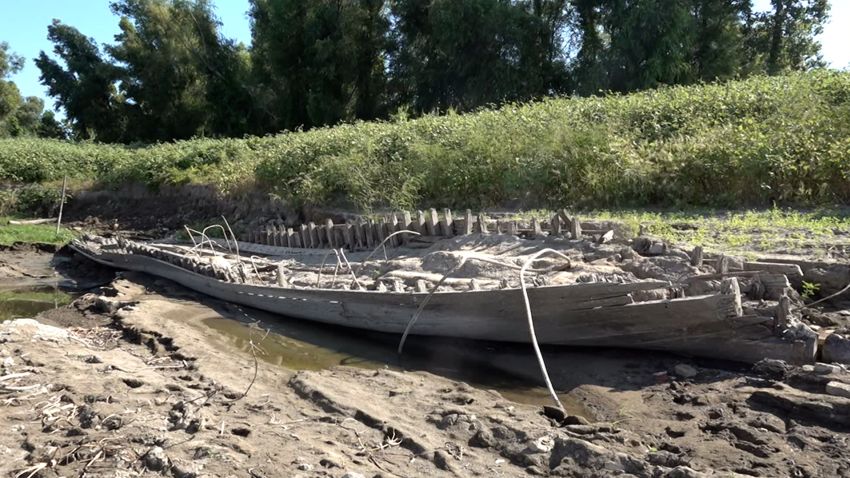
Severe drought reveals incredible discovery at bottom of Mississippi river
00:45
– Source:
CNN
Searing temperatures, lack of rainfall and low snowpack pushed some of the world’s most vital rivers to new lows this year.
Northern Italy saw its worst drought in more than 70 years. The 400-mile River Po hit a record low due to an unusually dry winter and limited snowpack in the Alps, which feeds the river. The drought impacted millions of people who rely on the Po for their livelihood, and roughly 30% of the country’s food, which is produced along the river.
Also fed by winter snowpack in the Alps along with spring rains, Germany’s Rhine River dropped to “exceptionally low” levels in some areas, disrupting shipping in the country’s most important inland water way. Months of little rainfall meant cargo ships began carrying lighter loads and transport costs soared.
Meanwhile in the US, extreme drought spread into the central states and gauges along the Mississippi River and its tributaries plummeted. Barge traffic moved in fits and starts as officials dredged the river. The Mississippi River dropped so low that the Army Corps of Engineers was forced to build a 1,500-foot-wide levee to prevent Gulf-of-Mexico saltwater from pushing upstream.

After more than a year of negotiations, Democrats in late July reached an agreement on President Joe Biden’s long-stalled climate, energy and tax agenda – capping a year of agonizing negotiations that failed multiple times.
Biden signed the bill into law in August and signaled to the world that the US is delivering on its climate promises.
Democratic Sen. Joe Manchin was influential in delaying the bill’s passage. Multiple White House and Biden administration officials for months had tried to convince the senator to support the bill over dinners in Paris and ziplining in West Virginia.
An analysis suggests the measures in the bill will reduce US carbon emissions by roughly 40% by 2030 and would put Biden well on his way to achieving his goal of slashing emissions in half by 2030.
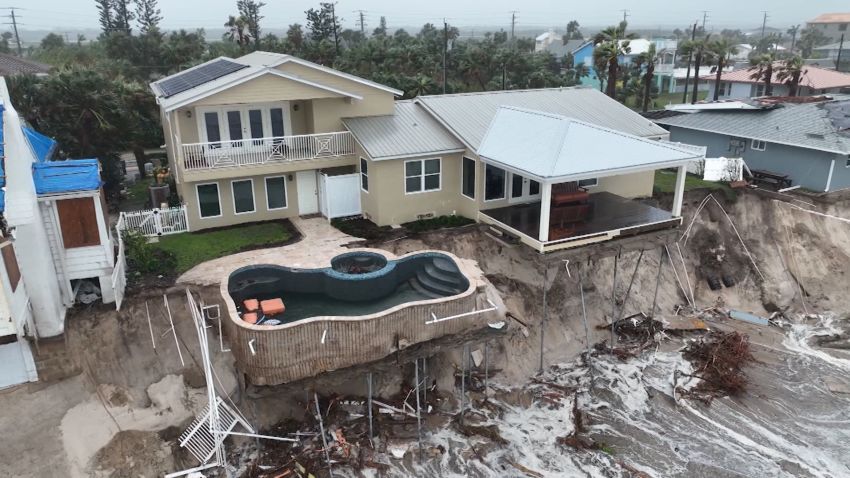
‘We are in trouble here in Daytona’: Coastal homes collapse into the ocean
01:00
– Source:
CNN
Hurricane Nicole was the first hurricane to hit anywhere in the US during the month of November in nearly 40 years. The rare, late-season storm also marked the first time that a hurricane made landfall on Florida’s east coast in November.
Although Nicole was only a category 1, it had a massive wind field that stretched more than 500 miles, coupled with astronomically high tides that led to catastrophic storm surge. Homes and buildings collapsed into the ocean in Volusia County, with authorities scrambling to issue evacuation warnings.
Hurricane Nicole flooded streets, destroyed power lines and killed at least five people. The storm came just 42 days after deadly category 4 Hurricane Ian wreaked havoc on the west coast of Florida.

Negotiators from nearly 200 countries agreed at the UN climate summit in Sharm el-Sheikh, Egypt, to set up a new fund for “loss and damage,” meant to help vulnerable countries cope with climate disasters. It was the first time wealthy, industrialized countries and groups, including longtime holdouts like the US and the EU, agreed to establish such a fund.
“We can’t solve the climate crisis unless we rapidly and equitably transition to clean energy and away from fossil fuels, as well as hold wealthy nations and the fossil fuel industry accountable for the damage they have done,” Rachel Cleetus, policy director and lead economist for the climate and energy program at the Union of Concerned Scientists, told CNN.
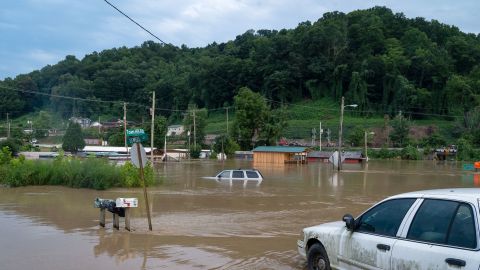
The summer’s series of floods started off in Yellowstone National Park in June, when extreme rainfall and rapidly melting snow washed out roads and bridges in the park, causing significant damage to the nearby town of Gardiner, Montana, at the park’s entrance. Authorities had to rescue more than 100 people from the floods.
The year also brought several 1,000-year rainfall events. A 1,000-year rainfall event is one that is so intense it’s only seen on average once every 1,000 years – under normal circumstances. But extreme rainfall is becoming more common as the climate crisis pushes temperatures higher. Warmer air can hold more moisture, which loads the dice in favor of historic rainfall.
Deadly flooding swept through Eastern Kentucky and around St. Louis in July after damaging, record-breaking rainfall in a short period of time.
California’s Death Valley, after a yearslong dry spell, saw its rainiest day in recorded history.
Meanwhile, down south, parts of Dallas, Texas, got an entire summer’s worth of rain in just 24 hours in August, prompting more than 350 high-water rescues.
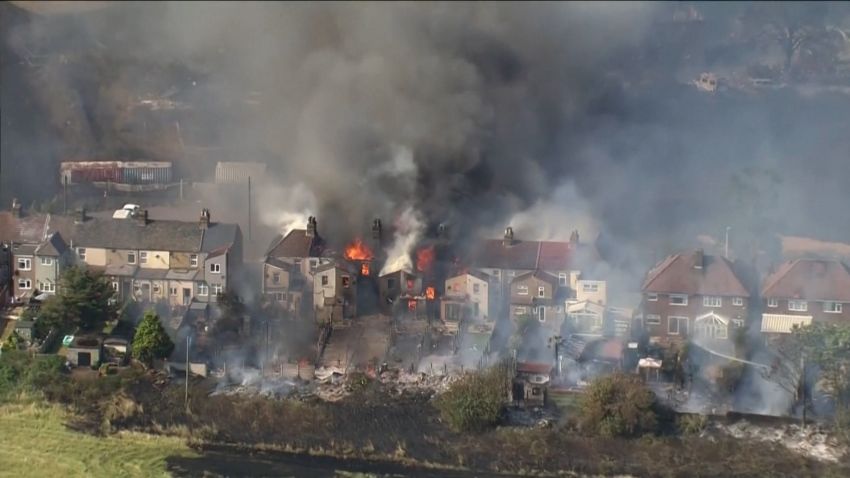
Wildfires threaten London during record-breaking heat wave
01:20
– Source:
CNN
Europe experienced its hottest summer on record in 2022 by a wide margin. While the heat kicked off early in France, Portugal and Spain, with the countries reaching record-warmth in May, the most significant heat came in mid-July, spreading across the UK and central Europe.
The UK, in particular, topped 40 degrees Celsius (104 degrees Fahrenheit) for the first time on record. Stephen Belcher, the UK Met Office’s chief scientist, said this would have been “virtually impossible” in an “undisrupted climate.”
Throughout western Europe, the heatwaves gravely increased wildfire risk, with one London fire official noting that the 40-degree day led to an “unprecedented day in the history of the London Fire Brigade.”

As water levels drop at this major lake, bodies begin to appear
03:19
– Source:
CNN
The past few years have been a reality check for western states that heavily rely on the Colorado River for water and electricity. Plagued by decades of overuse and a climate change-fueled drought, the river that serves 40 million people in seven western states and Mexico is draining at an alarming rate.
The water levels in its two main reservoirs – Lake Mead and Lake Powell – have plunged rapidly, threatening drinking water supply and power generation. In late July, Lake Mead – the country’s largest reservoir – bottomed out and has only rebounded a few feet off record lows. Its rapidly plunging levels revealed human remains from the 1970s and a sunken vessel from World War II.
The federal government implemented its first-ever mandatory water cuts this year for states that draw from the Colorado River, and those cuts will be even deeper starting in January 2023.
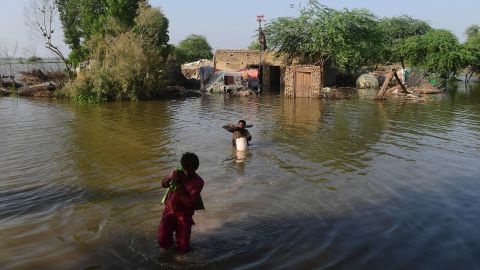
Floods caused by record monsoon rain and melting glaciers in Pakistan’s northern mountain regions claimed the lives of more than 1,400 people this summer, with millions more affected by clean water and food shortages. More than a third of Pakistan was underwater, satellite images showed, and authorities warned it would take months for the flood waters to recede in the country’s hardest-hit areas.
UN Secretary General António Guterres said the Pakistani people are facing “a monsoon on steroids,” referring to the role that the climate crisis had in supercharging the extreme rainfall. The hard-hit provinces Sindh and Balochistan saw rainfall more than 500% of average during the monsoon season.
Pakistan is responsible for less than 1% of the world’s planet-warming emissions, yet it is the eighth most vulnerable nation to the climate crisis, according to the Global Climate Risk Index.

Hurricane Ian was a Category 4 storm when it made landfall in southwest Florida in late September and left a trail of destruction from the Caribbean to the Carolinas. Insured losses from Ian are expected to reach up to $65 billion, according to recent data from reinsurance company Swiss Re.
The storm first struck Cuba before undergoing rapid intensification from a tropical storm to a category 3 hurricane in just 24 hours – something scientists told CNN is part of a trend for the most dangerous storms. That same week, Super Typhoon Noru in the Philippines grew from the equivalent of a category 1 hurricane to a category 5 overnight as residents around Manila slept, catching officials and residents unaware and unable to prepare.
Hurricane Ian’s size and intensity allowed it to build up a storm surge higher than any ever observed in Southwest Florida, devastating Fort Myers and Cape Coral. Ian killed more than 100 people, most by drowning. It will likely be one of the costliest hurricanes on record not only in Florida, but in the US.